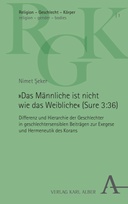Explore

How does the Qur'an construct ideas and norms of gender? Nimet Şeker delves into the fundamental Quranic concepts of gender, exploring whether a divine hierarchy between genders is established. The book investigates how pre-modern and contemporary exegetical thinkers have shaped and negotiated gender images. It sheds light on diverse hermeneutical and exegetical approaches, including those of classical and feminist scholars, and their impact on gender-specific interpretations. This work is intended for individuals interested in exegesis, theology, Islamic and religious studies, as well as gender studies.
This book is included in DOAB.
Why read this book? Have your say.
You must be logged in to comment.
Rights Information
Are you the author or publisher of this work? If so, you can claim it as yours by registering as an Unglue.it rights holder.Downloads
This work has been downloaded 31 times via unglue.it ebook links.
- 31 - pdf (CC BY) at Unglue.it.
Keywords
- divine hierarchy
- exegesis
- Feminine
- Gender Difference
- gender hierarchy
- gender images
- Gender Studies
- Hermeneutics
- Islam
- Islamic Studies
- masculine
- Nimet Seker
- pre-modernity
- Quran
- religious studies
- revelatory scripture
- Sura 3:36
- thema EDItEUR::Q Philosophy and Religion::QR Religion and beliefs::QRV Aspects of religion::QRVP Religious life and practice::QRVP7 Religious aspects of sexuality, gender and relationships
- Theology
Links
DOI: 10.5771/9783495993521Editions

